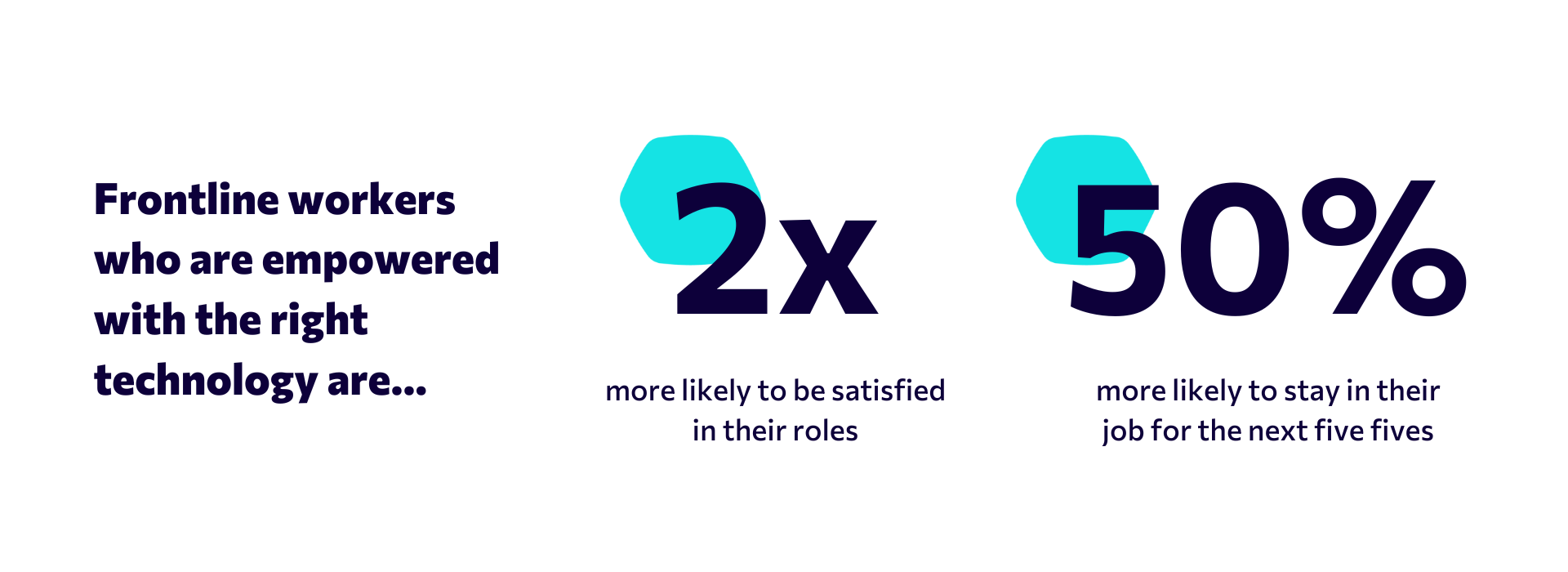Frontline employees are the backbone of many industries - whether they’re grocery store assistants, delivery personnel, restaurant servers or healthcare providers, these workers are often the first touchpoint customers will have with your business and are essential to maintaining a smooth operation.
Despite this, frontline employees are actually ranked among the least motivated. Often widely dispersed and isolated from HQ, these deskless workers are less likely to feel connected to the company they work for and therefore less motivated to achieve results.
Failure to motivate and engage frontline employees presents a big problem for employers, who risk higher turnover and decreased productivity as a result. In fact, 78% of business leaders say that connecting and empowering their frontline staff will be critical to their organization’s future success.
Read on to find out how to better motivate your frontline workforce and empower them to perform at their best.
Quick navigation:
- Why is it important to motivate your frontline employees?
- Motivating frontline workers post-Covid
- 5 key motivation strategies for frontline workers
- Communicate a clear mission and vision
- Recognize your workers
- Seek feedback
- Provide better technology
- Empower with information

Why is it important to motivate frontline employees?
The frontline workforce faces a unique set of challenges, far removed from the experience of traditional office employees. The dispersed nature of frontline work means that many employees face a lack of internal communication, making it difficult to stay connected with managers and keep up to date with the latest information.
Already facing an increased risk of work-related injuries and burnout, frontline workers who don’t receive the right support from their employers are left vulnerable, unmotivated and more likely to look elsewhere for work.
Conversely, deskless workers who are motivated and engaged in their jobs increase business profitability by 21%. When people feel invested in the company they work for and feel empowered to perform at their best, they display stronger relationships with colleagues and customers and are more likely to go the extra mile - bringing in 43% more revenue as a result.
Motivating frontline workers post-Covid
In times of uncertainty and instability, motivation is easily lost to feelings of deflation, disheartenment and the subsequent disengagement these lead to. 44% of employees under the age of 35 have reported that a lack of motivation since the start of the pandemic has hindered their performance at work.
Much has been said so far about making sure office-based employees’ transition to working from home is as productive and non-disruptive as possible. But for essential workers, there is no choice but to be on the frontlines in a time of crisis.
As a result, stress and burnout related to the pandemic has had a severe impact on the frontline workforce. The healthcare industry especially has been subject to immense pressure, and as a result has faced the largest decrease in motivation and engagement among its staff.
As we adjust to a post-Covid world, many industries are still recovering from the long-lasting effects of the pandemic and numerous lockdown periods. Businesses who hope to retain their workforce must act quickly and find ways to better support and motivate their frontline employees.
/unsplash-image-SI5Xmt2RYoY.jpg?width=777&name=unsplash-image-SI5Xmt2RYoY.jpg)
How to motivate your frontline employees: 5 key strategies
1. Communicate a clear mission and vision
When employees rally around a shared goal it gives context and meaning to their professional life - mission-aligned employees are actually 30% more likely to be high performers and 24% less likely to churn. For this reason, it’s important to communicate a clear vision and mission statement to your frontline workers.
Mission statement = covers the day-to-day, laying out primary objectives and unifying your people around a near to medium-term goal.
Vision statement = looks at the longer-term goals, i.e. ‘where do we want to be and how will we reach this?’
Your vision and mission lie at your company’s very core, they are the reason for its existence. You invested in them and your company’s early backers invested in them, so you need to make sure this investment extends to your workforce too.
How? By hitting home the purposeful nature of the service they are providing and the significance their role holds. But don’t just make it a one-off, it has to be executed in a sustained way. When people feel passionate, because they are doing something that is purposeful or worthwhile, they are intrinsically motivated to perform at their very best.
Take a look at Apple, who send daily, motivational video messages from their C-Suite. Seeing managers or executives impassioned, positive and enthusiastic energizes employees and boosts motivation, as well as maintaining their impressive 90% employee retention rate..png?width=1920&name=frontline%20worker%20motivation%20(1).png)
2. Recognize your workers
Recognition is a form of extrinsic motivation (motivation driven by external factors, like praise or reward) and a cornerstone of employee motivation. Providing attention in a personal way builds emotional bonds between you and your people.
The best way to build a recognition-rich culture is through an employee recognition program. Set a standard so people know what is required to achieve recognition, then embed that standard. Let employees recognise each other, so the flow of recognition is not one way.
This puts power back in employees’ hands, and makes them feel like all voices are of equal value rather than them feeling at the whims of senior management, or victims of favouritism. Peer-to-peer recognition is also 36% more effective than manager-only recognition.
The more your people see each other being recognised, and the more they feel like they are contributing to the success of the company, the more motivated they will be to replicate these recognition-gaining actions.
Here are some other ways to recognise your workers:
- Physical or virtual thank you or well done cards given to teams or individuals
- Company-wide or team-specific acknowledgement emails
- Flashcards or video messages in eduMe
- Recognition and rewards software like bonus.ly
- Social media praise
- ‘Employee of the week’ or a ‘wall of fame’ initiatives
- Badges or in-app visual features that signify milestones made or achievements ‘unlocked’
It really can be as simple as a ‘thank you’ - 75% of employees reported their motivation and morale would be boosted were they thanked by managers.
By putting high performance on a pedestal, highlighting individual successes and generally acknowledging your people you are showing that you appreciate the work that they do and value them as individuals, not just as a team.
/unsplash-image-AFaGrhbIn_U.jpg?width=2500&name=unsplash-image-AFaGrhbIn_U.jpg)
3. Seek feedback
There is no one that seeking feedback fails to benefit. It’s a window into your workforce’s soul.
By asking things like: ‘how do you feel?’, ‘what can we improve?’, ‘how helpful was lesson x on y?’, ‘what should we cover next?’, you are better informed on how best to serve your employees and contractors - it puts you in tune with their state of mind and needs.
Providing workers with the opportunity to give feedback also gives them a voice - employees that feel heard and listened to are 4.6 times more likely to perform at their very best.
By proactively seeking feedback, rather than just directing frontline employees to support lines or emails that will more likely fuel rather than resolve any agitation, you are saying: ‘we hear you and value you’.
Executing this doesn’t have to be a huge resource or time drain. One simple way to better keep a finger on the pulse of your workforce is to send out daily pulse surveys, which are easy for you to create and quick for them to complete.
While extensive, multi-question surveys suffer low completion rates and leave employees feeling frustrated, pulse surveys are designed to be quick and action-oriented. You can send out a single-question survey daily to check in with your team and see how their experience could be improved, and receive instant results that can be actioned straight away.
Collecting feedback on an ongoing basis means you can react effectively and adequately to support your frontline workers - it’s a win-win.
4. Provide better technology
The tools frontline employees are provided with have an immeasurable impact on their ability to do their jobs and provide a consistently high quality of service. Slow, outdated tech which interrupts their workflow acts as a barrier to productivity, and can leave workers feeling frustrated and unmotivated in their roles.
It’s for this reason that technology is a top priority among the deskless workforce, with 46% reporting that they even value technological tools above mental health support and wellness benefits. However, one-third of all frontline workers still do not have access to the right tools to do their job effectively.
Research has shown that dispersed workers who are empowered with sufficient technology are two times as likely to be satisfied in their roles, and over 50% more likely to stay at their job for the next five years.
So, we know that frontline workers need better technology to motivate them at work. But what does ‘better’ actually mean?
The most crucial step in improving frontline tech is ensuring that all tools are mobile-friendly. For a workforce that’s constantly on the go, having to sit down at a desktop and use clunky legacy systems is a significant barrier. Mobile tools are better suited to the nature of frontline work and enable employees to complete tasks quickly and effectively, whether they’re on the shop floor or out in the field.
5. Empower with information
Making information freely available to frontline staff is essential to maintaining a well-functioning business, and to keeping your dispersed workforce motivated.
Establishing a strong onboarding program is crucial in getting your frontline workers set up at the beginning of their employment, but many companies make the mistake of assuming that onboarding is enough. What happens when new product lines are introduced, policies change or performance waivers?
Without ongoing access to resources and opportunities to upskill, employees are more likely to become disengaged in their work and less motivated to perform.
That’s why it’s important to provide ongoing training which frontline workers can access whenever and wherever they need it. In fact, 67% of workers say they want regular digital skills training to improve their skills on-the-job, and 94% say they would stay longer at a company that invested in their learning.
The best way to make information and training readily available is to surface it right at the point of need, and remove any and all friction. This approach is referred to as seamless learning, where frontline workers are given one-tap access to relevant and engaging training content within the channel or platform they use the most. Whether it’s a widget in their native worker app, or a link embedded in a company email, employees are taken directly to a specific course without the need to log in.
To foster a culture of continuous learning, you can go one step further by triggering content based on worker behavior and wider company events. Delivery drivers who receive a poor customer rating can be suggested a refresher course on customer service, retail workers who are preparing for the holiday season can receive an update on the new product lines, and warehouse workers can be reminded to complete their yearly safety and compliance training.
When learning is contextual and relevant to workers’ day-to-day activities, it’s instantly more valuable. Establishing a comprehensive training program ensures that your frontline workers have all the information they need to do their jobs well, motivating them to keep upskilling and progressing within your company.
The takeaway
Maintaining a motivated and productive frontline workforce may seem like a daunting task, but with the right tools and strategies in place, it is possible. The key to frontline motivation is to put yourself in your workers shoes - what do they need in order to be successful at work?
Providing regular opportunities for feedback, ensuring that their hard work is recognised and involving them in your wider company goals will go a long way in boosting morale, but the most effective way to motivate your deskless employees is to lean on intelligent tech solutions.
Incorporating a tool which enables continuous learning through triggered notifications, embeds within existing frontline workflows and provides seamless access to knowledge is essential to keeping your dispersed workers engaged and happy at work. The less friction they experience in their day-to-day workflow, and the more opportunities they have to improve their skills, the more likely they are to feel motivated at work and picture a long term future at your company.
Already used by companies such as Uber, Marriott International and Grubhub, eduMe is the leading mobile training solution for the deskless workforce. Our pioneering seamless technology allows you to integrate training into your existing tech stack, giving frontline workers one-tap access to learning content within the apps they’re already using.
eduMe clients have already seen a 300% increase in engagement since implementing eduMe’s seamless mobile training. Book a demo now to see what we can do for your business 👇





